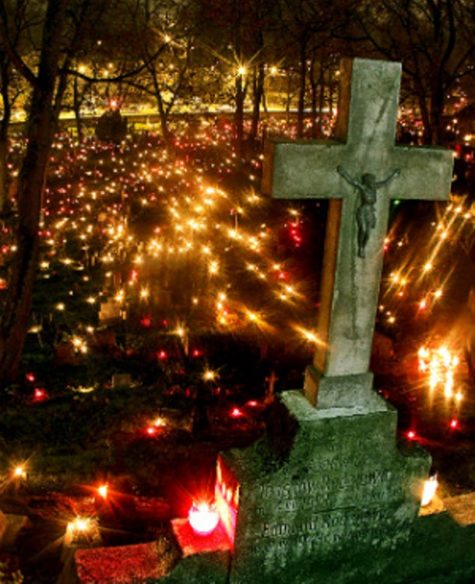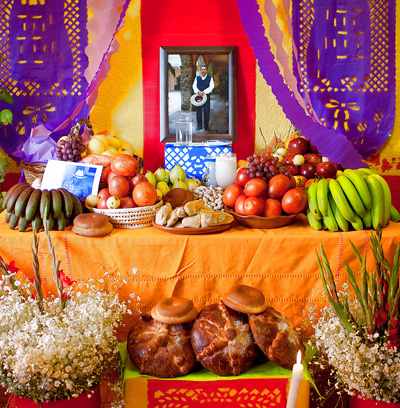There is a Mexican saying that we die three deaths: the first when our bodies die, the second when our bodies are lowered into the earth out of sight, and the third when our loved ones forget us.
Some believe that the origins of All Souls’ Day in European folklore and folk belief are related to customs of ancestor veneration practiced worldwide. It is practically universal folk belief that the souls of the dead (or those in Purgatory) are allowed to return to earth on All Souls Day. In Austria, they are said to wander the forests, praying for release. In Poland, they are said to visit their parish churches at midnight, where a light can be seen because of their presence. Afterward, they visit their families, and to make them welcome, a door or window is left open. In many places, a place is set for the dead at supper, or food is otherwise left out for them.
In any case, our beloved dead should be remembered, commemorated, and prayed for.
During our visits to their graves, we spruce up their resting sites, sprinkling them with holy water, leaving votive candles, and adorning them flowers (especially chrysanthemums and marigolds) to symbolize the Eden-like paradise that man was created to enjoy, and may, if saved, enjoy after death and any needed purgation.
Today is a good day to not only remember the dead spiritually, but to tell your children about their ancestors. Bring out those old photo albums and family trees! Write down your family’s stories for your children and grandchildren! Impress upon them the importance of their ancestors!
Traditional foods:
Around the world:
The formal commemoration of the saints and martyrs (All Saints’ Day) existed in the early Christian church since its legalization, and alongside that developed a day for commemoration of all the dead (All Souls’ Day). The modern date of All Souls’ Day was first popularized in the early eleventh century after Abbot Odilo established it as a day for the monks of Cluny and associated monasteries to pray for the souls in purgatory.
Many of these European traditions reflect the dogma of purgatory. For example, ringing bells for the dead was believed to comfort them in their cleansing there, while the sharing of soul cakes with the poor helped to buy the dead a bit of respite from the suffering of purgatory. In the same way, lighting candles was meant to kindle a light for the dead souls languishing in the darkness. Out of this grew the traditions of “going souling” and the baking of special types of bread or cakes.
In Tirol, cakes are left for them on the table and the room kept warm for their comfort. In Brittany, people flock to the cemeteries at nightfall to kneel, bareheaded, at the graves of their loved ones, and to anoint the hollow of the tombstone with holy water or to pour libations of milk on it. At bedtime, the supper is left on the table for the souls.
In Bolivia, many people believe that the dead eat the food that is left out for them. In Brazil people attend a Mass or visit the cemetery taking flowers to decorate their relatives’ grave, but no food is involved.
In Malta many people make pilgrimages to graveyards, not just to visit the graves of their dead relatives, but to experience the special day in all its significance. Visits are not restricted to this day alone. During the month of November, Malta’s cemeteries are frequented by families of the departed. Mass is also said throughout the month, with certain Catholic parishes organizing special events at cemetery chapels.
In Linz, funereal musical pieces known as aequales were played from tower tops on All Soul’s Day and the evening before.
In Mexico “Dia de Los Muertos” (Day of the Dead) is celebrated very joyfully — and colorfully. A special altar, called an ofrenda, is made just for these days of the dead (1 and 2 November). It has at least three tiers, and is covered with pictures of Saints, pictures of and personal items belonging to dead loved ones, skulls, pictures of cavorting skeletons (calaveras), marigolds, water, salt, bread, and a candle for each of their dead (plus one extra so no one is left out).
A special bread is baked just for this day, Pan de Muerto, which is sometimes baked with a toy skeleton inside. The one who finds the skeleton will have “good luck.” This bread is eaten during picnics at the graves along with tamales, cookies, and chocolate. They also make brightly-colored skulls out of sugar to place on the family altars and give to children.
Collected from various sources
Krazelna: Day of Hekate
Krazelna: Day of Hekate
Krazelna: Day of Hekate
Rachel V Perry: Emancipation Day
Rachel: The Nemesia






Leave a Reply